Table of Contents
ToggleOur world is shifting towards sustainable living, making growing your own veggies more tempting than ever. Whether you’re starting a small space vegetable garden in the city or on acres of land, our vegetable garden ideas will help. They turn your green area into a rich source of food.
If you’re into organic gardening, we have tips for you. These tips are good for the planet and produce a lot of food. We’ll show you how to grow a lot in a small area. You’ll also learn how to care for your garden using eco-friendly ways. Plus, you’ll get to enjoy fresh vegetables that you grew yourself.
Maximizing Small Spaces for Your Vegetable Garden
In cities, finding space for a garden is tough. But, there are smart ways to grow a lot using vertical gardening and container gardening. These methods are perfect for small areas and make your home look nice too.
Utilizing Vertical Planters
Vertical gardening means growing plants up, not out. It’s great for city folks who want to grow herbs, strawberries, or flowers. It saves precious ground space.
- Wall-mounted planters
- Freestanding vertical gardening frames
- Tower gardens for easy irrigation and care
Ingenious Hanging Baskets for Herbs and Greens
 Pin
PinHanging baskets are more than just for looks. They’re great for herbs and greens too. They hang on your balcony or patio, saving ground space.
By combining them with container gardening, you can use every inch wisely. Whether it’s mint, basil, or kale, hanging baskets are perfect. They’re good for planting lots of things.
- Select baskets that allow for proper water drainage to prevent root rot.
- Choose greens that have similar light and water requirements for successful cohabitation.
- Consider adding a water-retaining layer to reduce watering frequency.
Using these methods in small spaces makes gardening fun and efficient. It’s a great way to make your living area greener. You can start a new hobby or improve what you have. With clever gardening, you can do a lot in a little space.
Implementing Raised Bed Gardening in Your Backyard
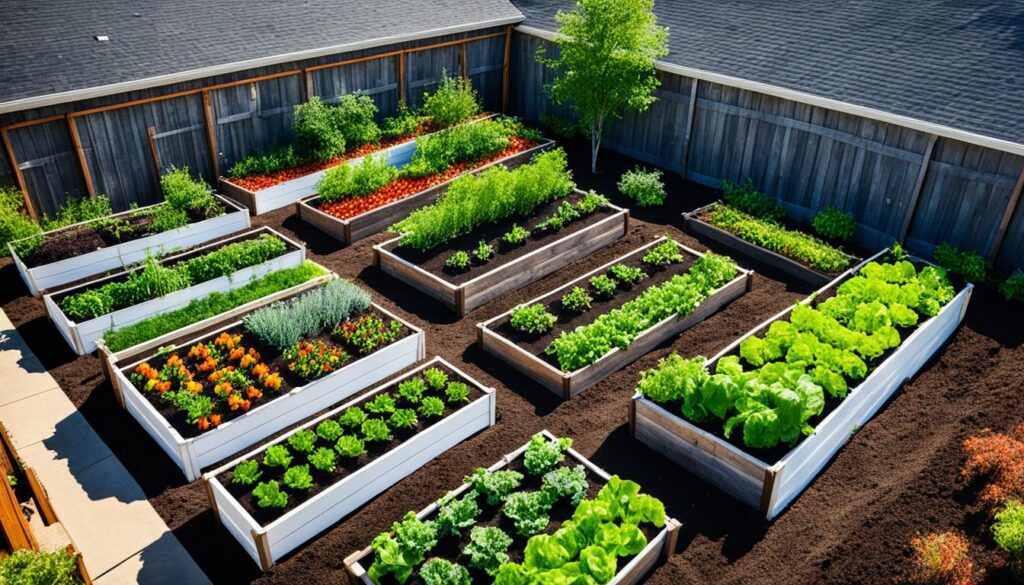 Pin
PinExploring raised bed gardening helps your backyard garden design look better. It changes how you grow vegetables for the good. Raised beds are key in vegetable garden ideas because they tackle many gardening problems.
Raised beds improve drainage and control soil, making a great spot for vegetables to grow. To start raised bed gardening in your backyard design, follow these steps:
- Choose the Right Location: Pick a sunny, well-aired, and easy-to-reach area in your backyard.
- Select Your Materials: You can use wood, stone, or metal for making raised beds. Choose based on your budget and style.
- Design Your Beds: Decide on bed size and height for your plants. Make them narrow enough to reach the center easily.
- Prepare and Fill Your Beds: Start with a weed barrier on the bottom. Then, fill with a mix of topsoil and compost for good plant growth.
Raised bed gardening improves your gardening and makes your backyard design look structured and beautiful. It helps both new and experienced gardeners. Raised beds make the garden easier to handle and more fruitful.
Benefits of Companion Planting
Embracing companion planting is a key part of organic gardening tips. It also makes edible landscaping better. This method helps gardeners improve their garden’s health and productivity the natural way.
Best Companion Plants for Tomatoes
Tomatoes do well with friends like basil, marigolds, and carrots. Basil keeps away pests and makes the tomatoes taste better. Marigolds prevent harmful insects, and carrots save space by growing under the tomatoes.
Creating a Harmonious Garden Ecosystem
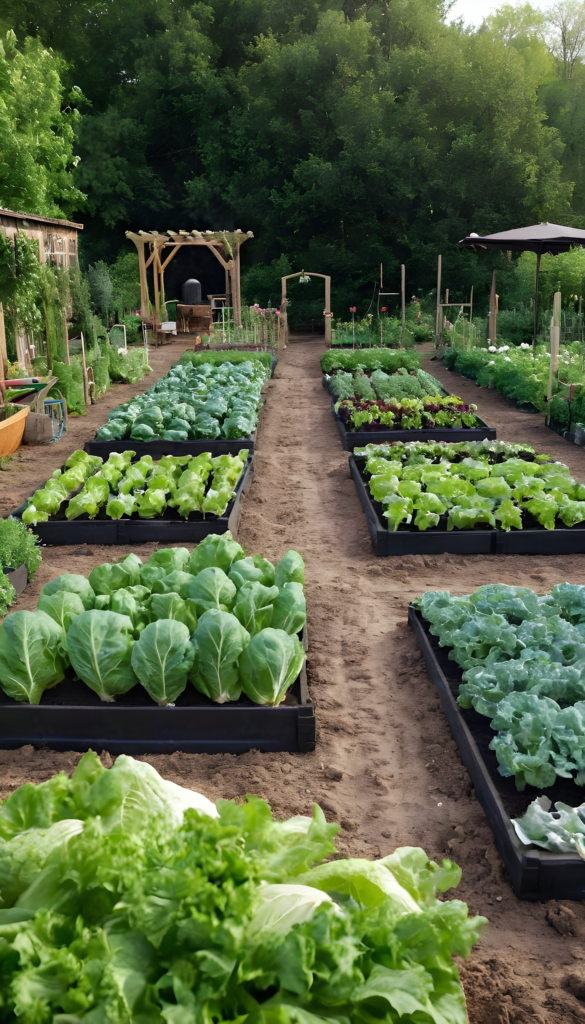 Pin
PinCompanion planting aims for a balanced garden. Different plants help each other out, leading to better pollination, healthier soil, and pest control. This approach is key for a successful edible landscaping project.
- Natural Pest Control: Some plants release substances that bugs don’t like. This helps reduce the need for harmful pesticides.
- Soil Health: Many types of plants give the soil different nutrients. This keeps the soil rich and fertile.
- Improved Pollination: A mix of flowers attracts bees. This is important for plants that bear fruit.
Container Gardening: Versatile and Space-Efficient
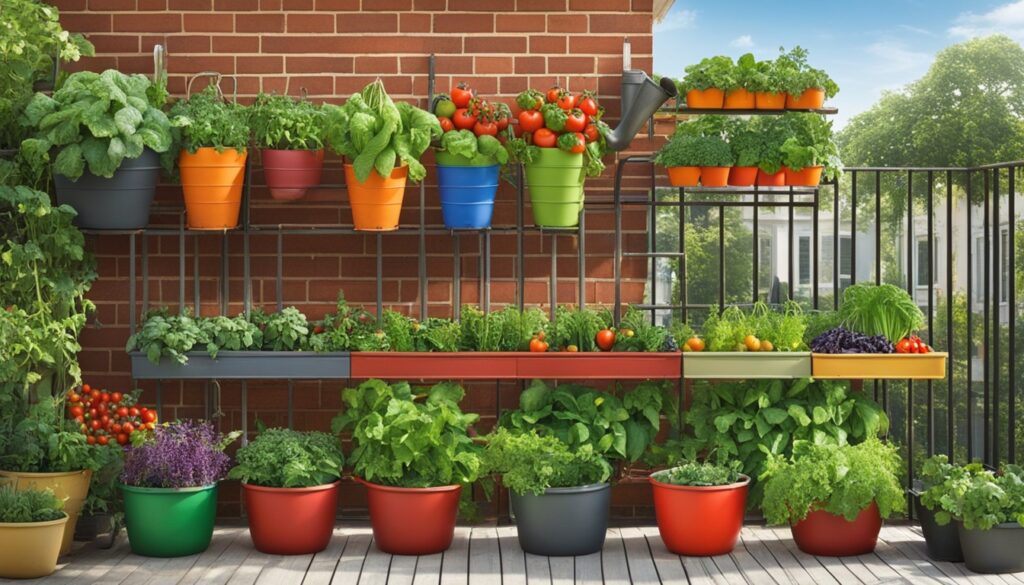 Pin
PinLooking to maximize your small space vegetable garden? Try container gardening. Its space-saving design is perfect for city dwellers or those with small yards. With containers, you can grow various veggies right outside your door.
Container gardening is great for any space. Choose the right pots and know your plants’ needs for a successful garden. Here’s how to make your container garden thrive:
- Pick containers that fit the veggies you want to grow, considering their root depth requirements.
- Make sure each pot has good drainage to avoid waterlogging, which can harm your plants.
- Think about the pot material since different types can impact how often you need to water.
Container gardens also make your space more beautiful. Mixing different container shapes and plants can turn your area into a green paradise. With some planning, you can make any small spot a vibrant vegetable garden.
Moving containers to catch the best sunlight is easy. This means you can protect your plants from extreme heat or give them more light as needed. Flexibility in gardening is a significant benefit of using containers.
Gardening in containers makes growing your own food simple. It’s for anyone, even those with limited outdoor space. Try it for more fresh produce at home or to bring the beauty of nature closer to you.
Exploring the World of Edible Landscaping
Edible landscaping changes how we see gardens, mixing beauty with function. This method makes gardens look good and supports the earth through organic practices. It lets gardeners enjoy both the sights and the tastes of their harvested goods.
Incorporating Edible Plants into Ornamental Designs
Adding edible plants to ornamental ones turns a garden into a visual and taste delight. Plants like berries, herbs, and greens can add exciting colors and textures to the scenery. This mix turns the garden into a lively, diverse space.
Functional and Aesthetic Garden Layouts
Creating a garden meant to be eaten and admired calls for careful design. Using tips like mixing plants to keep pests away aids the garden’s well-being and look. Edible plants alongside paths and as garden borders can make the space not just beautiful, but fun to explore, too.
- Choose plants with seasonal variety to ensure year-round appeal and harvest.
- Integrate shrubs and small trees for vertical height and structure.
- Include aromatic herbs near walkways for a sensory experience.
By adding edible features, gardens can be full of flavor and visually stunning. These efforts aren’t just about having a pretty space. They connect us with nature and help us live more sustainably. With the right steps, anyone can make their garden a place that thrives year-round.
The Art of Organic Gardening Tips
 Pin
PinGetting into organic gardening tips improves your vegetable garden ideas. It also leads to a healthier way of life. By using methods like companion planting, you can make your garden more green and full of life.
Organic gardening means no synthetic chemicals. Instead, you use natural options. This keeps your soil healthy, your water clean, and your garden diverse.
- Creating Organic Compost: Make rich compost from kitchen scraps, garden waste, and other natural materials. It helps your soil a lot.
- Natural Pest Control: Say no to chemical pesticides. Invite useful bugs, use neem oil, and plant pest-repelling plants. It’s all about keeping balance.
- Soil Management: Test your soil often to make sure it has what your plants need. This way, they grow well without any fake stuff.
Following these organic gardening tips does a lot. You get better, tastier veggies. More importantly, you help the Earth. With techniques like companion planting, your garden turns into a lively place. It supports many different plants and creatures.
Creating a Backyard Garden Design Master Plan
Every successful gardener starts with a solid master plan for their backyard. This plan is crucial, no matter your preferred gardening method. It could be raised beds, containers, or planting directly in the soil. Detailed planning and careful execution are keys to successful gardening. Let’s walk through creating your perfect garden plan.
Mapping Out Your Planting Strategy
When planning your garden, think about every corner of your outdoor area. Start by checking how much sun each spot gets. This will help you decide where to plant things. For example, raised beds are great for veggies that need special care.
- Start by sketching a rough layout, marking areas for raised beds or containers.
- Factor in accessibility for watering and maintenance, ensuring paths are wide enough for easy movement.
- Consider crop rotation over the seasons to maintain soil health and optimize plant growth.
Choosing a Color Scheme for Visual Appeal
Your garden should not only be productive but also beautiful to look at. Choose a color scheme that matches your style and home. Add plants with colorful flowers or leaves for a pop of brightness.
- Choose a primary color based on the flora that thrives in your climate zone.
- Integrate secondary colors that either contrast or blend harmoniously with your primary choice.
- Incorporate small bursts of unexpected color to catch the eye and add interest.
With careful planning, incorporating both raised beds and containers, your garden will be a joy to be in. Remember, your main goal is a garden that is both pretty and useful. Making your garden beautiful and productive will make your gardening experience better.
Innovative Irrigation Systems for Vegetable Gardens
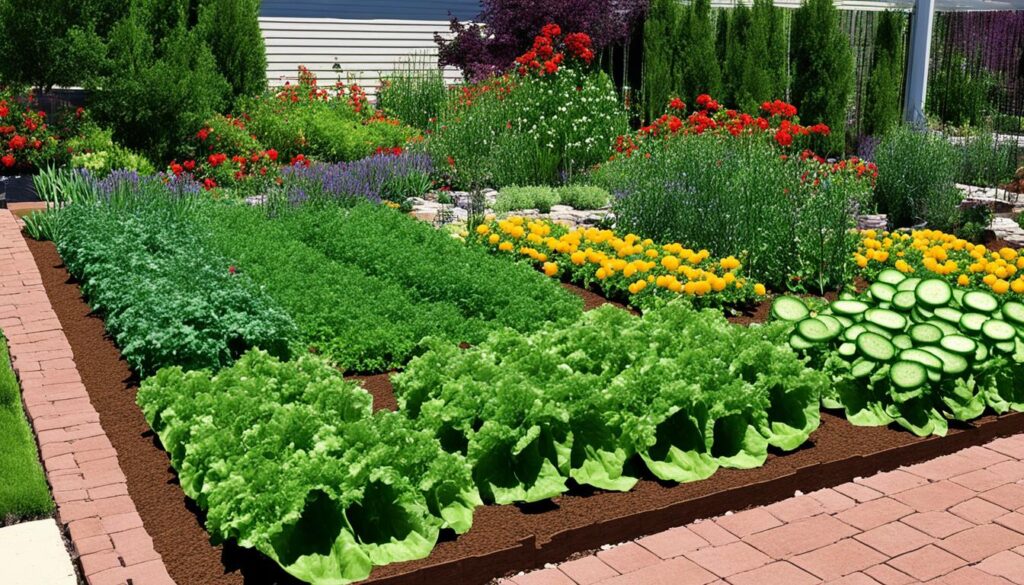 Pin
PinWhen we look into vegetable garden ideas, we come across new ways to water our plants. Innovative irrigation systems have changed the game. They save time and use water wisely, perfect for both small and big gardens.
Learning organic gardening tips reminds us about using water well. New irrigation methods lead this effort. There are simple drips and high-tech systems that check the weather to water better. They all help keep the soil moist with little effort.
- Drip Irrigation: Delivers water directly to the root zone, reducing evaporation and runoff.
- Soaker Hoses: Ideal for rows of plants, releasing water slowly through porous materials.
- Automated Sprinkler Systems: Can be programmed to water the garden at the most effective times of day or night, which helps reduce water waste and supports strong plant growth.
Using these systems helps your plants grow well and saves water. This is key for gardening that’s good for the planet. People aiming for big vegetable harvests in an organic garden can see a big improvement by changing how they water.
- Start by knowing what your garden needs, like its climate and the plants you’re growing.
- Pick an irrigation system that matches both your budget and how much time you can put into it.
- Keep an eye on your system and adjust it when the garden’s needs change.
Adding these new systems to your garden helps you water smarter, which is key for a successful vegetable plot.
Vegetable Garden Ideas for Year-Round Harvest
Creating a vegetable plot that provides year-round crops is a lofty, yet achievable, goal. It doesn’t matter if your growing area spans acres or is confined to a small space vegetable garden. The secret to a constant supply of veggies is careful planning and picking the right plants. This way, your garden flourishes in every season, delivering fresh veggies all year.
Succession Planting Techniques
Succession planting is your key to an uninterrupted supply of fresh veggies. It means not planting everything at once but rather at different times. This keeps your garden productive all the time. When one crop is done, the next one is ready to take its place, making the most of your garden space.
- Start with fast-growing vegetables like lettuce and radishes, which can be replanted multiple times during the season.
- Consider weather conditions and crop sensitivity when planning your planting schedule.
Choosing Varieties for Continuous Yield
Picking the right plants is vital for a full year of harvests. You should choose crops that ripen at different times. This way, you won’t be left without something to pick and eat. A good mix of early and late varieties is a smart move.
- Choose cold-tolerant varieties such as kale, Brussels sprouts, and carrots for late fall and winter harvesting.
- Incorporate perennial vegetables like asparagus and rhubarb which provide yields year after year.
By using smart raised bed gardening and planting methods, small areas can become highly productive. It all comes down to good planning for a thriving vegetable garden all year.
Embracing the Beauty of Vertical Gardening
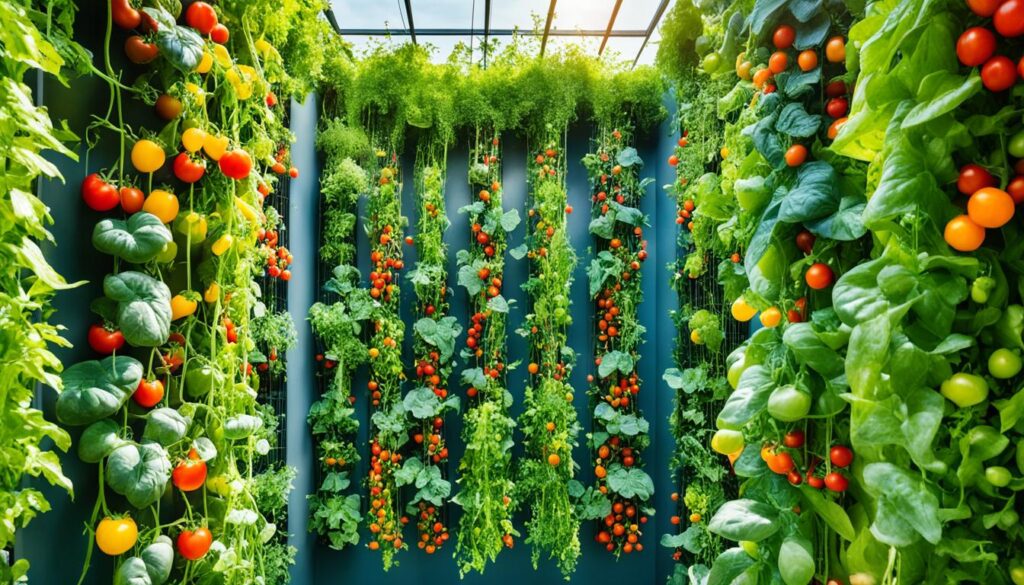 Pin
PinAs cities grow more crowded, vertical gardening becomes a beautiful solution. It mixes functionality with elegance, tackling the issue of limited space. This method not only uses up vertical room efficiently, but it’s also vital for edible landscaping and container gardening projects.
Vertical gardens employ tools like trellises, green walls, and tiered planters. Such structures allow a lot of green to fit in a little space. They turn dull walls and fences into dynamic, living features.
- Trellises: Great for growing climbing plants up, making gardens more interesting.
- Living walls: They’re like a nature painting, with a mix of plants that help the environment.
- Stacked planters: Perfect for growing things like herbs, strawberries, and greens in a small space.
Vertical gardening is about using small spaces wisely and artistically arranging plants. It’s a core method in container gardening and edible landscaping. Growing up instead of out changes how we see planting. It brings beauty and lots of produce to gardens, big and small, in both personal and shared areas.
Integrating Smart Farming Practices
Welcome to the world of smart farming where tech and tradition meet. This mix changes the way we think about organic gardening tips and vegetable garden ideas. With smart tools, your raised bed gardening can be better. Your veggies will grow in top conditions.
Automated Soil Monitoring
Automated soil systems have changed how we manage our gardens. They check soil moisture and nutrients all the time. This info helps your plants stay healthy and increases the harvest. For organic gardening lovers, this technology is a perfect match. It gives plants only what they need, keeping things sustainable.
Advanced Composting Methods
Composting turns waste into garden gold, benefiting your plants. Today, we’ve improved composting to make even better soil. Methods like vermicomposting and bokashi fermentation speed up composting. They also add good microbes to the soil, which is key for strong vegetable gardens.
- Automated composting bins control temperature and moisture. They stop smells and speed up the process.
- Smart sensors in compost bins warn you about pH and moisture problems. This keeps the compost in great shape.
With smart farming, your gardening gets easier and better. It makes your garden more productive, sustainable, and simpler to look after.
Attracting Pollinators to Your Vegetable Garden
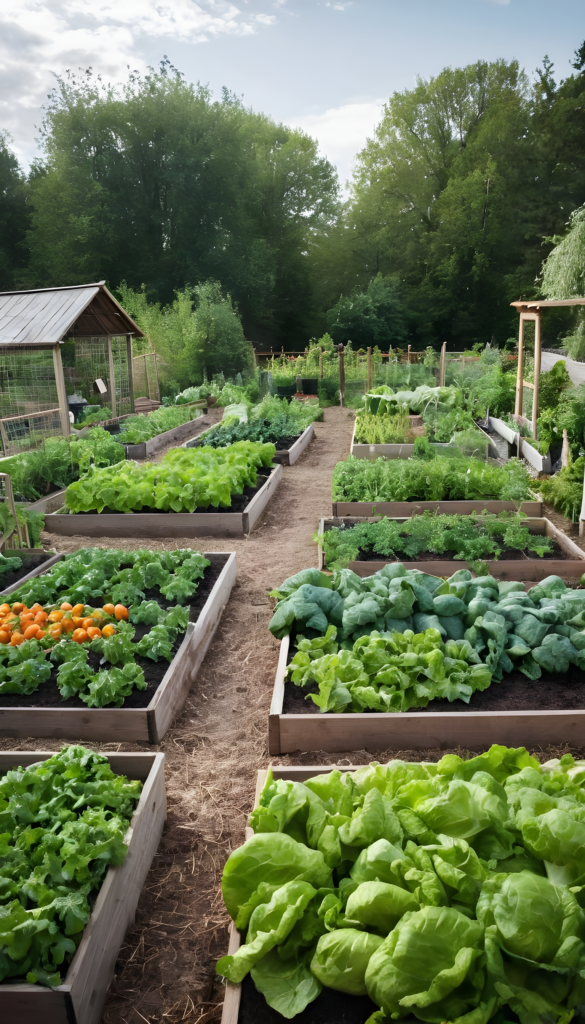 Pin
PinOrganic gardening thrives with pollinators, crucial for vegetable growth. These flying friends turn flowers into fruits and seeds. Mixing flowers with veggies makes a beautiful and useful space. Choose blooms that attract pollinators to create a lively garden.
For patios and balconies, container gardens are perfect for pollinators. You can place various plants at different levels to meet their needs. Lavender, basil, and marigold are great choices. But, be careful with pesticides; they can harm these beneficial insects.
Creating a welcoming environment for pollinators is key in any garden. Offer water and nesting spots, along with plants blooming from early spring to late fall. Following these steps not only helps your garden but also aids in protecting pollinators. A healthy garden leads to a good harvest.










